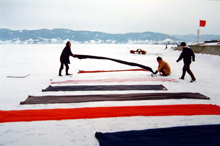4a
日本概念派(1)オブジェを消せ
Japanese Conceptualists (1) Get Rid of Objects
【本文確定】
「6月1日の深夜裏座敷にねていた私は『オブジェを消せ』という声を聞いた。私にとってそれは美術を文章だけで表現せよという意味であることを疑いもしなかった。6月4日、そう決めた。観念美術が誕生した」。
自筆年譜にこう記していた松澤宥は、1964年、物質を消去し言葉を呈示するだけで美術であると主張する観念美術を創始しました*4a1。これは、ジョセフ・コスースがコンセプチュアル・アートを開始する1年前のことでした*4a2。
1964年6月20日から始まった「アンデパンダン64」に松澤宥は「プサイの死体遺体」を出品。これが最初の観念美術の発表となりました。同作は言葉が印刷されただけの1万枚のチラシ(血裸子)で、「プサイ」とは、彼がそれまで作り続けてきた情念的な作品題名に使われていた言葉でした。すなわち彼にとっての観念美術は、自作の否定そして物質の否定であり、その意味では反芸術の一つの帰結といえました。一方で言葉あるいは観念は肯定されました。物質不信と観念希求の図式としては、プラトンのイデア論との同型性を指摘できると私は考えます。
1964年12月、長野県の山中で「荒野におけるアンデパンダン ’64展」を企画。美術雑誌に出したその広告には「物質を信ずるなかれ 感覚を信ずるなかれ 眼を信ずるなかれ/あなたの出品物はあなたの手元に置いて それから発する無形のもの(虚の作品)を会場まで届けて下さい」との神秘的な文言が並べられました。1966年、東京で「松澤宥物質消滅式1966」を執行。これは「大キャンヴァスが毎日縮減して行って最後に無くなって終うのをキャンヴァスに対峙した椅子に座って見るというもの」でした。1967年、裏側には何も書かれていないはがきを知人に郵送するシリーズ「ハガキ絵画」を開始。第1回発信の表側(宛名面)には「すべての生物および無生物のための白紙絵画/人間に見せるのみならず 岩にも樹にも天にも鳥獣にも音楽にも自己増殖機械にも 私はそれを見せる 見よそこに ただ白色の円を」との超越的な文言が並べられました。
このように松澤宥の観念美術は物質の不在それ自体を作品内容とした点において、また、東洋神秘主義めいた粉飾をまとった点において、西洋のコンセプチュアル・アートとは区別されます。しかしながら初期に米国留学時の研究課題を「美の定量」とし、その後も美術の本質を問い続けた結果、自己否定の内在化として物質を捨象し概念性への還元を行ったという点においては、還元主義の一典型であるともいえます。還元主義は、美学的意味におけるモダニズムです*4a3。
"As I was sleeping in a detached back parlor, I heard a voice saying, 'Get rid of objects.' I had no doubt it meant to say express art only with words. On June 4th, I decided that's how it will be. The conceptualist art was born."
This was a statement written in the 1964 section of an autobiographical chronology by Matsuzawa Yutaka, who originated conceptual art one year earlier than Joseph Kosuth based on the argument that the act of getting rid of physical materials and presenting only words can be valid as art*4a1 *4a2.
On June 20th of the same year, he exhibited a work which consisted of ten thousand flyers called "The Dead Corpse of Psi" at "Independent 64" and became the first conceptual art work to be exhibited. This work was only flyers with printed words on them, and "psi" was a word he used quite frequently in his emotional titles for the works he has done. That is to say conceptual art for him was a rejection of his own work and of materials, and in this sense, it was a justifiable conclusion to anti-art. This idea in which words are acknowledged on one hand with distrust for material and longing for conceptualism on the other is on par with Plato's Idealism.
On December of the same year, "Independent '64 in the Wilderness" was planned in the mountains of Nagano Prefecture. An advertisement for this event with enigmatic wordings in art magazines read, "Don't believe in materials, don't believe in sensations, don't believe your eyes / Leave behind your art work and bring the formless work (the imaginary work) to the venue." Two years later, "Matsuzawa Yutaka Disappearing Material Ceremony 1966" was carried out in Tokyo. This involved sitting on a chair placed right in front of a canvas and watching it reduce in size day by day until it disappears. In 1967, he started a series called "Postcard Paintings" in which postcards with nothing written on the back were sent out to his acquaintances, and on the first batch of postcards sent out, the front part of the postcards where names and addresses are written had a transcendental text which read "Blank Painting for All Living Organisms and Non-living Organisms / Not only will I show it to human beings, but I will also show it to rocks, trees, heaven, birds and beasts, music and self-reproductive machines. Look there, at a white circle."
As can be understood from these actions, Matsuzawa Yutaka's conceptual art can be distinguished from those of the West in a way that the condition of the absence of materials itself became his works and the fact that his works were adorned with Eastern mysticism. After doing research on "the determination of beauty" and contemplating over the essence of art, he reduced art to conceptualism by abstracting materials as an act of making immanent his self-denial. This act is undeniably typical of reductionism, and modernism in the sense of aesthetics is manifested here*4a3.
